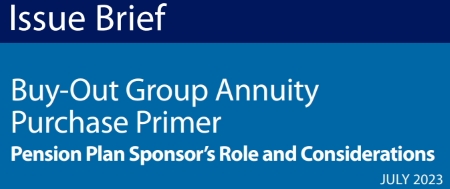‘Challenge’ Is Embraced by Stakeholders Seeking Social Security Solution
By Ted Gotsch
The release of the Academy’s Social Security Challenge is being praised by the public, policymakers, and in the press alike as an effective way of raising attention to the high-stakes issues facing the nation’s primary federal retirement program and how solutions can be found to address the financing challenges it faces.

An interactive web-based app, the Social Security Challenge explains the current financial state of Social Security to users and allows them to consider different scenarios that would close the financing gap so it could continue to fund the full benefits that older Americans receive under the program. Those scenarios include cuts to Social Security benefits, increases in taxes, or a combination of both. Reform options that would increase costs but would address some of the perceived shortcomings of the current structure are also included.
“The Academy is pleased at the reception the Challenge has received from a host of stakeholders around the country,” Academy Senior Pension Fellow Linda K. Stone said. “From the start, our intention was to help Americans achieve a better understanding of Social Security and what options existed to address its financing challenges.”
The app’s rollout caught the attention of Rep. John Larson of Connecticut, the ranking member of House Ways & Means Social Security Subcommittee, who contacted the Academy directly to say he was “really pleased with the stuff you’ve been doing around taking the Social Security Challenge.”
Emerson Sprick, senior economic analyst for the Bipartisan Policy Center, told The Street that he was “optimistic that The Social Security Challenge can help Americans think more clearly about the problem at hand and the compromises we must make.”
The app was developed by the Academy as a public service to objectively inform, stimulate, and advance the public dialogue on Social Security reform, drawing on the U.S. actuarial profession’s knowledge and expertise on risk and financial security issues and the Academy’s extensive body of work informing and advising policymakers on Social Security’s financial condition and reform options.
Challenge users visit “Townsville” and select specific locations-the park, the gym, a grocery store, and a coffee shop. They meet regular people going about their lives who share their stories and thoughts with one another about various Social Security reform options and their potential impact. The characters in the Challenge include people in various life stages and those in different life circumstances.
The financial effects of the reform option provisions in the Challenge come from the Office of the Chief Actuary at the Social Security Administration and are based on the most recent Summary of Provisions that Would Change the Social Security Program. An updated version of that report is expected over the next few months and the Challenge will be updated to reflect the most recent information.
Finding answers to ensure the retirement program’s solvency is a serious matter. Trust fund reserves are small compared to the value of all the benefits that Social Security will pay, and these reserves are declining.
A smaller working population relative to beneficiaries means there are fewer workers paying taxes to support each beneficiary. The retirement of the baby boom generation is increasing the number of beneficiaries faster than the increase in the number of covered workers, as lower-birth-rate generations enter the workforce.
The number of Americans 65 and older will increase from about 58 million in 2022 to about 75 million by 2035. According to the 2023 Social Security Trustees Report, Social Security’s combined trust fund reserves are projected to become depleted in 2034, potentially leading to a forced 20% cut in payable benefits unless legislative changes are adopted to prevent it.
Assuring that Social Security stays strong means that Congress may need to evaluate very different reform options with complex and wide-ranging impacts-options such as making higher levels of income subject to payroll taxation or raising Social Security’s normal retirement age-and then pass the reforms it chooses so that they can become law.
The Challenge app allows users to develop a reform approach by traveling through the virtual town and puzzling through choices. In the finale, participants select and submit an approach from a palette of possible reform options and see how well it works to address the solvency issue. Experts said the app gives users a realistic taste of the serious choices facing the nation when it comes to Social Security.
“I think it really translated it to the stakes for ordinary people,” said Kathleen Romig, director of Social Security and Disability Policy at the Center on Budget and Policy Priorities. “It didn’t feel-no offense to actuaries, but it’s not as if you were reading a dense actuarial report or something like that. You were hearing from typical people and how these issues impact them.”
Mark Hulbert, author of the Retirement Weekly column at MarketWatch, wrote, “If you had any doubt that there are numerous ways in which Social Security’s solvency can be restored, you should take the ‘Social Security Challenge.'”
Ted Gotsch is the Academy’s senior policy analyst for content and publications.
Getting the ‘Challenge’ Message Out
The release of the Social Security Challenge this spring has resulted in a significant response as shown by media mentions, the number of people visiting the Academy’s website, and social media traffic.
The Challenge has garnered more than 350 news mentions thus far, appearing in such outlets as CNBC, Yahoo! Finance, MarketWatch, Fortune, the Los Angeles Times, and The Arizona Republic. In published reports, journalists have heralded the Challenge’s ability to engage Gen X and young generations on the topic of Social Security, among other things.
Jason Russell Nominated to Be Next Pension VP

Russell
The Nominating Committee in June reported on a slate of incoming vice presidents, to succeed those whose two-year terms will be up in November, and will join the Academy’s Board of Directors during Envision Tomorrow, the Academy’s annual meeting, Nov. 14-15.
In the pension sphere, Jason Russell was nominated as vice president, succeeding Sherry Chan. Russell has been a member-selected director since 2020 and has served on many Pension Practice Council (PPC) committees-including as chairperson of the Multiemployer Plans Committee-and has presented to Congress on behalf of the PPC.
Webinar Examines Trustees Report
The Academy hosted an April 25 webinar, “Social Security Trustees Report: A Deep-Dive Discussion With the Program’s Actuaries,” which examined the recently released report that showed Social Security’s retirement and disability programs have sufficient resources to fully cover benefits until 2034, one year earlier than projected last year.
Key highlights from the detailed recap of the webinar include:
- OASDI reserve depletion date moves up one year to 2034.
- Shift is due to net change in actuarial deficit of -0.19% of payroll.
- Top reason for increasing cost relative to payroll and GDP is the drop in birth rates.
- Benefit cuts, tax increases, or a combination of both can sustain OASDI long term.
- In order for any changes to be implemented, Congress must take action.
‘One-pager’-Ahead of its forthcoming issue brief on the status of the Trustees Report, the Social Security Committee released a one-page snapshot of the program’s financing challenges.
Committee Releases Buy-Out Group Annuity Purchase Primer Issue Brief

The Pension Committee released an issue brief, Buy-Out Group Annuity Purchase Primer-Pension Plan Sponsor’s Role and Considerations.
A traditional pension plan is designed to provide participants with a steady stream of income once the participant retires. Plan sponsors are increasingly active in transferring the responsibility for making pension payments, and the associated risks, to another party. This issue brief focuses on “buy-out” annuity contract transactions, one of the ways pension plan sponsors transfer pension payment responsibilities and associated risks to other parties. A webinar on this issue brief is slated for this fall.
Academy ERISA Advisory Council Presentation
The issue brief was also submitted to the U.S. Department of Labor’s ERISA Advisory Council for consideration in advance of the council’s July 18 public meeting on pension risk transfers. At the meeting, Academy Senior Life Fellow Nancy Bennett and Paul Navratil, chairperson of the Life Investment and Capital Adequacy Committee, gave an overview of life insurance regulations focused on the regulatory framework governing solvency requirements, including the establishment of liabilities and required capital for benefit obligations that are the result of a pension risk transfer.
Webinar Examines Fixed Rate Pension Funding
The May 18 pension webinar, “Fixed Rate Pension Funding: A Discussion of the Practice Note,” featured presenters who examined the Public Plans Committee’s February practice note, Fixed Rate Pension Funding.
While public sector pension plan contributions are often made based on the actuarial calculations, many public plans make contributions that are simply a statutory fixed contribution rate without explicit respect to the actuarially determined contribution.
During this webinar, our speakers walked through the new practice note. Attendees heard about current and emerging ideas for working with these plans.
Slides and an on-demand recording are available as a member benefit.
Senior Pension Fellow Linda K. Stone met with Republican and Democratic Senate Finance Committee staff members assigned to work on Social Security issues.
The Academy’s strategic outreach on public policy topics continued in June with a presentation to the Actuaries’ Club of the Southwest. Social Security Committee member Jerry Mingione delivered a virtual presentation addressing “Social Security Financial Challenges and Reform Options.” He gave an overview of Social Security’s financial condition, key drivers of the program’s financing, and reform options, with insights from Academy resources, including issue briefs and the Social Security Challenge.
Pension Public Policy News in Brief
- The Pension Committee in June released a practice note, Selecting and Documenting Pension Assumptions Other Than Discount Rate, Investment Return, and Mortality, updating a 2009 practice note. The practice note was revised to reflect updated actuarial standards of practice (ASOPs), including changes in ASOP Nos. 27 and 35, effective for actuarial reports issued on or after Aug. 1, 2021.
- Also in June, the Pension, Multiemployer Plans, and Public Plans committees submitted comments to the Actuarial Standards Board regarding proposed revision of ASOP Nos. 27 and 35.
- The Lifetime Income Joint Risk Committee released Experience-Sharing Lifetime Income (ESLI), an issue brief considering the ESLI retirement income scheme being used in many other countries, which shares features of both lifetime annuities and structured drawdowns.
Early Registration Deadline This Summer for Envision Tomorrow

Early registration discounts are available now for Envision Tomorrow, the Academy’s Annual Meeting, to be held Nov. 13-14 in Washington, D.C. George Will, author and political columnist, and Mona Chalabi, data journalist, will kick off each day with their keynote addresses. The professionalism general session will feature Tim Hwang, an expert in AI, machine learning, and technology ethics, who will dive into the issues raised by these topics. Register early for the best rates.
Volunteers Sought for Risk Transfer Work Group
The Pension Committee is forming a work group to draft an issue brief focusing on participant experience when benefits are transferred from a plan sponsor to an insurer. Interested? Email Philip Maguire, pension policy analyst, at maguire@actuary.org.
Legislative/Regulatory Activity
Federal
President Biden on June 3 signed into law HR 3746, the Fiscal Responsibility Act of 2023, legislation that raised the U.S. debt ceiling so that the country would not default on its financial obligations. By reaching an agreement that extends the nation’s ability to borrow into January 2025, the measure ensures that Social Security recipients will continue to receive their monthly checks from the program during that time without delay.
The House on June 5 approved HR 2593, a bill that would establish the Senior Investor Taskforce within the Securities and Exchange Commission. The taskforce would be charged with reporting on topics relating to investors over the age of 65, including industry trends and serious issues impacting such investors, and make recommendations for legislative or regulatory actions to address problems encountered by senior investors. As part of the measure, the Government Accountability Office must report on the financial exploitation of senior citizens. The Senate has not acted on the measure.
State
Vermont Gov. Phil Scott gave his approval to S 135 on June 1, a bill that would create VTSaves, an automatic IRA program. Contributions will be made to a Roth IRA, but the state treasurer has the authority to add the option of a traditional IRA as well. All employers in the state with 25 or more employees must offer the program as of July 1, 2025.
Minnesota Gov. Tim Walz signed HF 783, the Minnesota Secure Choice Retirement Act, into law on May 19-legislation that will automatically enroll workers at participating companies in the state into an IRA. Companies with five or more employees that do not currently offer a retirement plan will be required to participate. The program will take effect no later than Jan. 1, 2025.
Walz on May 19 signed into law HF 3100, which among other things changes the actuarial investment return assumptions for several Minnesota state and local government pension plans. The legislation lowers it by 0.5 percentage points a year to 7% overall.
The Nevada Legislature passed SB 305, legislation that would establish the Nevada Employee Savings Trust as an auto-IRA program and mandate all private-sector employers in the state with an electronic payroll system to offer a retirement program. Covered employees would be enrolled in the program automatically.
The Missouri Legislature has given its approval to SB 20, a measure that addresses several retirement-related provisions. At the top of the list is the establishment of the Show-Me MyRetirement Savings Plan, a voluntary multiemployer retirement plan that would allow businesses to come together and participate in a state-facilitated plan. The bill also addresses several retirement systems for public safety officials in the state.
The Pennsylvania House passed HB 577 on May 24, legislation that would create the Keystone Saves Program Fund-a state-sponsored retirement plan with auto-enrollment. The bill allows enrolled employees to set their own contribution levels, increase or decrease deductions, or opt out altogether.
Indiana Gov. Eric Holcomb signed two pieces of legislation that place conditions on how money for state pensions can be invested. HB 1008, signed into law on May 4, prohibits the state pension board from beginning or continuing contracts with investment service providers that make environmental, social, and governance (ESG) commitments unless compliance would violate their fiduciary duty or no comparable provider exists. Another bill, SB 268, would prohibit the Indiana public retirement system from investing in entities controlled by China or the Chinese Communist Party. Gov. Holcomb signed that measure on May 1.
Florida Gov. Ron DeSantis on May 2 approved HB 3, a bill that places restrictions on the use of ESG factors when state and local government make investment decisions, including for general revenue, trusts dedicated to specific purposes, money held by retirement plans, and surplus funds. Investment decisions, including written policies and the exercise of shareholder rights, may not sacrifice investment return. The attorney general is authorized to bring civil or administrative actions to enforce provisions of the bill.
DeSantis also signed SB 7024, legislation that would grant eligible retirees of the Florida Retirement System Pension Plan the right to receive a monthly retiree health insurance subsidy payment, restoring benefits that were cut in 2011. It also would increase the state’s contribution to Florida’s retirement fund by 2 percentage points. The measure was signed into law on June 5.
Tennessee Gov. Bill Lee on April 18 signed into law HB 884, which revises the methods by which a local government employer wishing to participate in Tennessee Consolidated Retirement System must pay the estimated increased pension liability created by a benefit improvement. It also requires the state to pay the estimated increased pension liability resulting from a benefit improvement affecting general employees or employees at institutions of higher education participating in the retirement system by amortizing the unfunded accrued liability for no longer than 10 years from the date that the benefit improvement is established.
Kentucky Gov. Andy Beshear signed off on legislation April 6 that would raise the minimum monthly annuity from the Police and Fire Retirement Fund of urban county governments to $1,500 a month. SB 206 also creates a provision that would allow the minimum benefit to be raised every two years to no more than 10% above the federal government poverty guidelines for a family of two.
AARP spotlighted the Academy’s Social Security Challenge with a feature story on its website that introduced the app to visitors and cited favorable reviews of the app by outside experts on Social Security financing. The Motley Fool Money podcast mentioned the challenge in a discussion of reform options.
A CBS News article discussing the Social Security Trustees Report cited remarks from the Academy’s April webinar on the report.
Pensions & Investments cited a reference to ASOP No. 27, Selection of Economic Assumptions for Measuring Pension Obligations, in a story on public employee pension plan investment return assumptions.
A CNBC retirement-planning article mentioned a researcher’s recommendation of the Actuaries Longevity Illustrator, co-sponsored by the Academy and the SOA.
Mondaq reprinted an article from accounting and tax firm ORBA that draws extensively on Academy resources in a discussion of Social Security’s financial challenges and reform options.
A GoBankingRates story, also published by Yahoo! Finance and AOL, on Social Security benefit comparisons referred to Academy research on gender-related factors that can cause differences to the benefits women and men receive from Social Security.
US News & World Report quoted Senior Pension Fellow Linda K. Stone in a story on life expectancy.